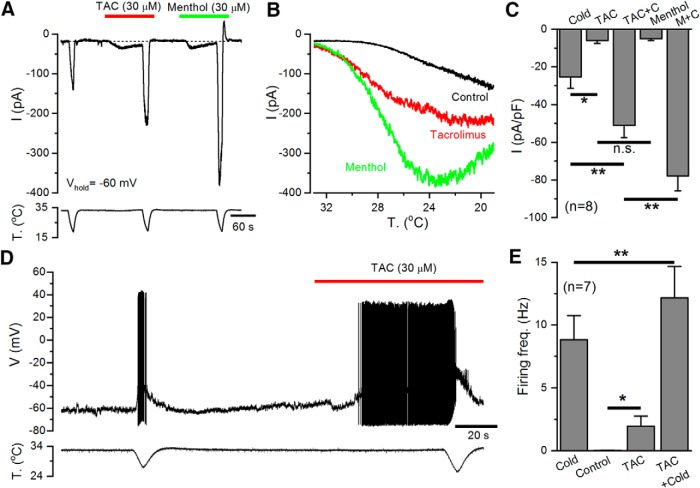Figure 10.
TAC increases the excitability of cold-sensitive DRG neurons. A, Representative whole-cell recording in the voltage-clamp configuration (Vhold = −60 mV) of a TRPM8-expressing, cold-sensitive DRG neuron identified by the expression of EYFP. TAC (30 μm) evoked an inward current similar in amplitude to that elicited by menthol (30 μm). Both TAC and menthol strongly potentiate the response to cold. Bottom, Simultaneous recording of bath temperature during the recording. B, Current-temperature relationships for the same neuron in control (black trace) and in the presence of 30 μm TAC (red trace) or 30 μm menthol (green trace). Note the marked shift in temperature threshold. C, Bar histogram summarizing the effects of agonists on the amplitude of inward currents during the protocol shown in A. The statistical analysis consisted of a one-way ANOVA followed by Bonferroni's post hoc test (*p < 0.05, **p < 0.01). D, Representative recording of a cold-sensitive DRG neuron in the whole-cell current-clamp configuration showing responses to cold and to the application of TAC (30 μm). TAC evoked AP firing at 33°C and greatly enhanced the firing frequency during a cold ramp. Bottom, Simultaneous recording of bath temperature. E, Bar histogram summarizing the mean responses, measured as average firing frequency, during the different stimuli applied. Firing frequency for cold was averaged from the first to the last spike during the cooling ramp. Firing frequency in control condition was calculated during the minute preceding TAC application (only 3 of 7 neurons fired action potentials in control conditions). TAC-evoked firing was calculated from the first spike during TAC application to the start of the cold ramp. The analysis consisted of a paired t test for cold versus TAC plus cold (**p = 0.009) and control vs TAC (*p = 0.048).

